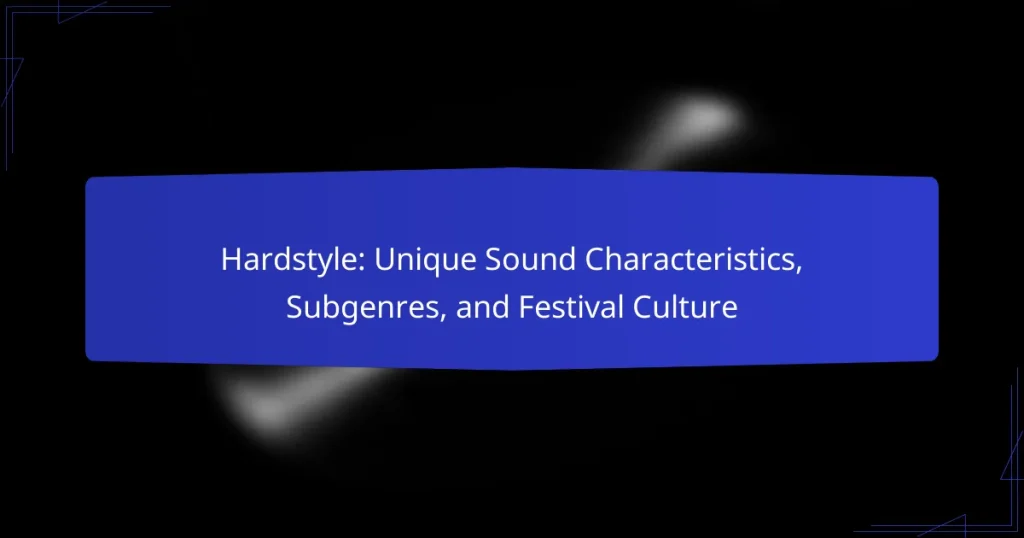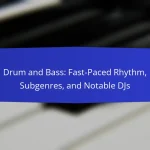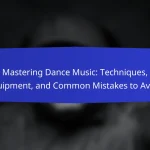Hardstyle is a genre of electronic dance music characterized by its heavy basslines, distorted kick drums, and melodic elements, typically ranging from 140 to 150 beats per minute. Originating in the late 1990s in the Netherlands, Hardstyle evolved from hard trance and hardcore techno, creating an energetic and euphoric atmosphere often showcased at large music festivals like Defqon.1 and Qlimax. The genre includes subgenres such as Raw Hardstyle, Melodic Hardstyle, and Euphoric Hardstyle, each with distinct characteristics catering to different audiences. The festival culture surrounding Hardstyle emphasizes vibrant gatherings, elaborate stages, and a strong sense of community, fostering connections among fans through shared passion and self-expression.

What is Hardstyle?
Hardstyle is a genre of electronic dance music known for its distinctive sound. It typically features a heavy bassline, distorted kick drums, and melodic elements. The tempo generally ranges from 140 to 150 beats per minute. Hardstyle originated in the late 1990s in the Netherlands. It evolved from genres like hard trance and hardcore techno. The genre is characterized by its energetic and euphoric atmosphere. Hardstyle is often associated with large music festivals, such as Defqon.1 and Qlimax. These events showcase the genre’s vibrant culture and community.
How did Hardstyle originate?
Hardstyle originated in the late 1990s in the Netherlands. It emerged from the fusion of hard trance, techno, and hardcore genres. DJs and producers sought to create a distinct sound that featured heavy bass and distorted kicks. The genre gained popularity through underground raves and dance events. Early pioneers included artists like Showtek and Headhunterz. They helped define the style with their unique productions. By the early 2000s, Hardstyle had developed a dedicated following. It became a staple in dance festivals, further solidifying its presence in electronic music.
What cultural influences shaped the development of Hardstyle?
Hardstyle developed through various cultural influences, primarily from the Dutch rave scene. The genre emerged in the late 1990s and early 2000s, blending hard trance, techno, and hardcore elements. This fusion created a distinct sound characterized by heavy bass and melodic riffs. The influence of early hard dance music is evident in its rhythmic patterns. Additionally, the rise of electronic dance music (EDM) festivals played a significant role in popularizing Hardstyle. Events like Defqon.1 and Qlimax showcased Hardstyle artists, further embedding the genre in rave culture. The community surrounding these festivals contributed to its growth, fostering a dedicated fan base. Thus, the cultural landscape of the Netherlands significantly shaped Hardstyle’s evolution.
Who are the key figures in the history of Hardstyle?
Key figures in the history of Hardstyle include DJ Zany, Headhunterz, and Showtek. DJ Zany is recognized for his early contributions to the genre in the late 1990s. Headhunterz gained prominence in the 2000s, shaping the sound of Hardstyle with his innovative productions. Showtek, initially known for Hardstyle, later transitioned to mainstream electronic dance music but left a lasting impact on the genre. These artists played pivotal roles in popularizing Hardstyle at festivals and events, helping to define its unique characteristics. Their influence is evident in the evolution of the sound and culture surrounding Hardstyle music.
What are the unique sound characteristics of Hardstyle?
Hardstyle is characterized by its heavy bass, distorted kicks, and melodic elements. The tempo typically ranges from 140 to 150 BPM. Hardstyle often features a four-on-the-floor beat structure. The kick drum is usually distorted and punchy, creating a unique sound. Melodies are often uplifting and emotional, contrasting with the aggressive beats. Vocals can range from spoken word to melodic singing. Breakdown sections are common, providing contrast to the intense drops. Hardstyle has roots in hard trance and hardcore techno, influencing its distinct sound.
What defines the typical tempo and rhythm of Hardstyle?
The typical tempo of Hardstyle ranges from 140 to 150 BPM. This tempo establishes a fast-paced energy suitable for dance. The rhythm is characterized by a strong kick drum on every beat. This creates an aggressive and driving feel. Hardstyle also features syncopated basslines and melodic elements. The combination of these elements enhances the genre’s intensity. The use of reverse bass is a notable characteristic in many Hardstyle tracks. This rhythmic structure contributes to its distinct sound and appeal.
How do basslines and melodies contribute to Hardstyle’s sound?
Basslines and melodies are essential components of Hardstyle’s sound. The basslines provide the genre’s signature heavy and punchy rhythm. They typically feature distorted kicks that create a driving force in tracks. This rhythmic foundation enhances the intensity and energy of Hardstyle music. Melodies in Hardstyle often serve to evoke emotional responses. They are usually characterized by uplifting and anthemic qualities. These melodies complement the aggressive basslines, creating a dynamic contrast. Together, they establish a unique sound that defines Hardstyle. This combination contributes to the genre’s popularity at festivals and events.
What role do vocals play in Hardstyle tracks?
Vocals in Hardstyle tracks serve to enhance emotional engagement and provide lyrical storytelling. They often convey themes of empowerment, resilience, or celebration. The integration of vocals creates a connection with listeners, making tracks more memorable. Vocals can vary in style, from melodic singing to aggressive shouting. This diversity adds layers to the overall sound. Additionally, they can act as hooks, drawing listeners into the track. The use of sampled or original vocals is common in the genre. Studies have shown that vocal elements significantly impact audience response during live performances.
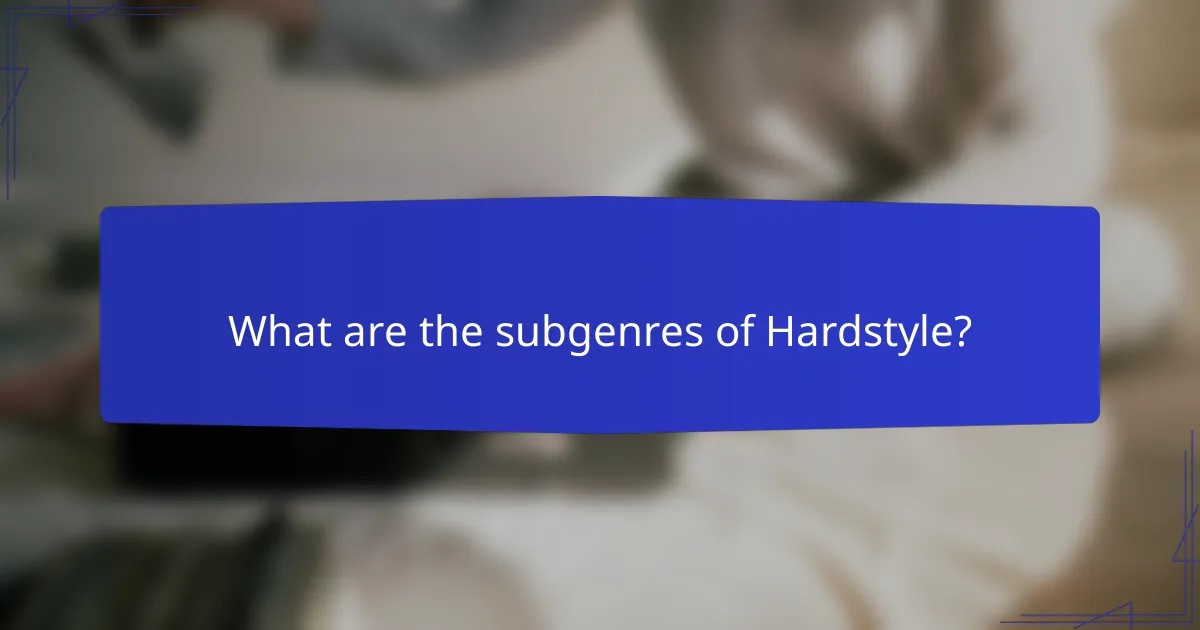
What are the subgenres of Hardstyle?
The subgenres of Hardstyle include Raw Hardstyle, Melodic Hardstyle, and Euphoric Hardstyle. Raw Hardstyle features aggressive sounds and heavy bass. Melodic Hardstyle focuses on melodic elements and emotional themes. Euphoric Hardstyle combines uplifting melodies with energetic beats. Each subgenre has its own distinct characteristics that cater to different audiences. These classifications help define the diverse landscape of Hardstyle music.
How do subgenres differentiate within Hardstyle?
Subgenres within Hardstyle differentiate primarily through their tempo, sound design, and thematic elements. For instance, Raw Hardstyle features a darker sound with aggressive kicks and distorted melodies. In contrast, Euphoric Hardstyle emphasizes melodic and uplifting elements, often incorporating emotional vocals. Furthermore, the tempo can vary, with some subgenres maintaining a consistent range around 150 BPM, while others may experiment with faster or slower beats. Each subgenre also attracts different audiences, influencing festival lineups and event themes. The distinct characteristics of these subgenres create a diverse landscape within the Hardstyle genre.
What are the characteristics of Raw Hardstyle?
Raw Hardstyle is characterized by its aggressive sound and heavy bass. It features distorted kick drums that create a powerful rhythm. The tempo typically ranges from 150 to 160 BPM. Melodies in Raw Hardstyle are often dark and intense. Vocals can include samples from various genres or are completely absent. The production style emphasizes rawness and authenticity. This subgenre often incorporates elements from hard trance and hardcore. Festivals showcasing Raw Hardstyle include Defqon.1 and Qlimax, highlighting its popularity in the electronic dance music scene.
What defines Euphoric Hardstyle?
Euphoric Hardstyle is a subgenre of Hardstyle characterized by melodic elements and uplifting vibes. It typically features high-energy beats combined with euphoric melodies. This style often includes emotional vocals and anthemic choruses. The tempo usually ranges from 150 to 160 BPM. Euphoric Hardstyle aims to create a sense of joy and elation on the dance floor. It is popular at festivals and events, attracting large crowds. Notable artists in this genre include Headhunterz and Wildstylez. The sound is defined by its ability to evoke strong emotional responses from listeners.
How does Hardcore influence Hardstyle subgenres?
Hardcore influences Hardstyle subgenres primarily through its tempo, intensity, and sound design. The BPM range of Hardcore, typically between 160-200, sets a precedent for Hardstyle’s energetic pace. Hardstyle often incorporates heavy kicks and distorted bass, traits derived from Hardcore music. The aggressive melodies and vocal samples in Hardcore also find their way into Hardstyle tracks. Additionally, the emotional and thematic elements from Hardcore resonate within various Hardstyle subgenres. This influence is evident in subgenres like Raw Hardstyle, which emphasizes darker, more intense sounds. The crossover between Hardcore and Hardstyle is further highlighted in festival lineups, showcasing artists from both genres. This blending of styles creates a unique auditory experience at events.
What are some emerging trends in Hardstyle subgenres?
Emerging trends in Hardstyle subgenres include the rise of raw Hardstyle and melodic Hardstyle. Raw Hardstyle features heavier kicks and darker themes. Melodic Hardstyle emphasizes emotional melodies and uplifting elements. Another trend is the fusion of Hardstyle with other genres, such as trap and dubstep. This blending creates innovative sounds and attracts diverse audiences. Collaborations between artists from different subgenres are also increasing. Festivals are showcasing these subgenres more prominently. This shift reflects the evolving tastes of Hardstyle fans and the genre’s adaptability.
How are new technologies impacting Hardstyle production?
New technologies are significantly transforming Hardstyle production. Digital audio workstations (DAWs) allow for intricate sound design and editing. Software synthesizers enable producers to create unique sounds and textures. High-quality plugins enhance mixing and mastering capabilities. Sampling tools provide access to a vast library of sounds. Automation features streamline the production process. Collaboration platforms facilitate remote teamwork among artists. These advancements lead to more innovative and polished Hardstyle tracks. The result is a continuously evolving genre that attracts a wider audience.
What influences are shaping the future of Hardstyle subgenres?
The future of Hardstyle subgenres is shaped by technological advancements, evolving musical tastes, and cultural influences. Technology, such as digital audio workstations and production software, enables artists to experiment with new sounds. This experimentation leads to the emergence of hybrid subgenres that blend Hardstyle with other electronic music styles.
Additionally, the growing popularity of streaming platforms influences how music is consumed. Artists are adapting their sounds to cater to a broader audience. Cultural events and festivals also play a significant role in shaping Hardstyle’s evolution. These gatherings introduce fans to diverse influences, encouraging cross-pollination of styles.
As a result, Hardstyle continues to evolve, reflecting both its roots and contemporary trends in the electronic music landscape.
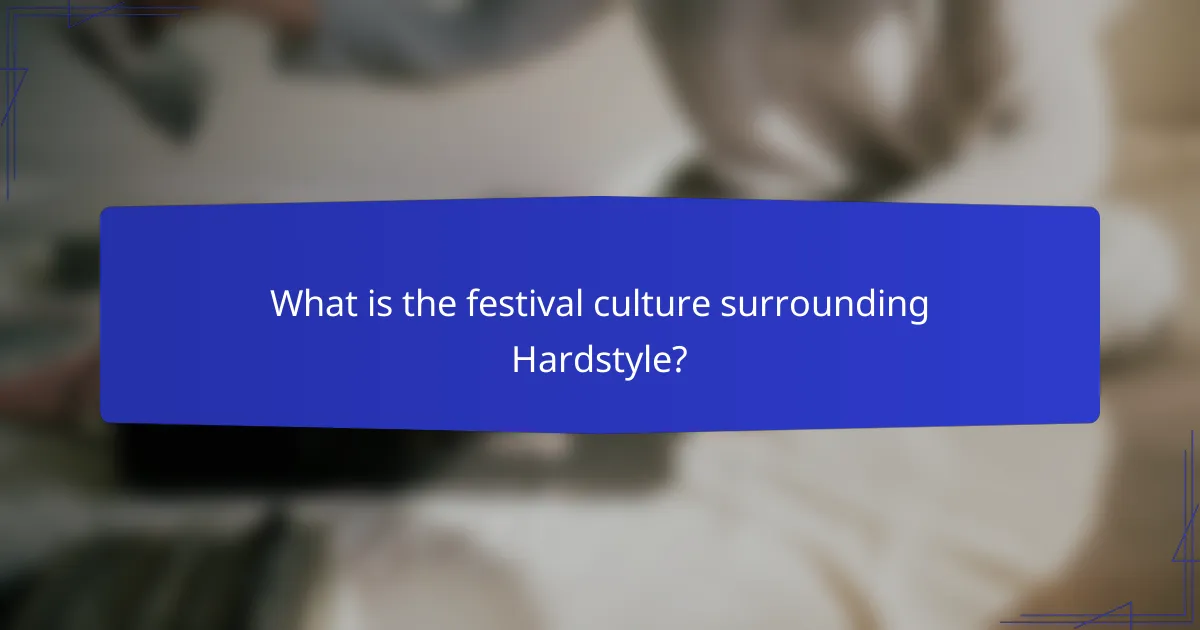
What is the festival culture surrounding Hardstyle?
The festival culture surrounding Hardstyle is characterized by vibrant, energetic gatherings focused on electronic dance music. These festivals often feature elaborate stages, immersive light shows, and a strong sense of community among attendees. Hardstyle festivals typically attract thousands of fans who share a passion for the genre. Events like Defqon.1 and Qlimax are iconic in the Hardstyle scene. They showcase top artists and promote an atmosphere of unity and celebration. The culture emphasizes self-expression through dance, fashion, and art. Fans often dress in unique styles, showcasing creativity and individuality. The festival experience fosters connections and friendships among attendees, enhancing the overall enjoyment of the music.
How do Hardstyle festivals contribute to its community?
Hardstyle festivals contribute to their community by fostering social connections and promoting local culture. These events bring together fans from diverse backgrounds, creating a sense of unity. They provide a platform for local artists to showcase their talent, enhancing the local music scene. Economic benefits arise as festivals attract tourism, boosting local businesses. According to a study by the European Festival Association, festivals can generate significant revenue for host cities. Additionally, Hardstyle festivals often support charitable causes, further strengthening community ties. This combination of social, economic, and cultural contributions underscores the positive impact of Hardstyle festivals on their communities.
What are the most notable Hardstyle festivals worldwide?
The most notable Hardstyle festivals worldwide include Defqon.1, Qlimax, and Tomorrowland. Defqon.1, held in the Netherlands, is one of the largest Hardstyle festivals. It attracts tens of thousands of attendees each year. Qlimax, also in the Netherlands, is known for its unique stage designs and themes. Tomorrowland, while primarily an electronic dance music festival, features a dedicated Hardstyle stage. Other notable festivals include Hard Bass and Decibel Outdoor, both popular in the Hardstyle community. These festivals showcase top Hardstyle artists and create immersive experiences for fans.
How do festival experiences enhance the appreciation of Hardstyle?
Festival experiences enhance the appreciation of Hardstyle by immersing attendees in the culture and energy of the genre. Festivals provide a unique environment where fans can connect with like-minded individuals. The shared experience of live performances amplifies the emotional connection to the music. High-quality sound systems and visual effects at festivals elevate the auditory experience. Engaging performances by renowned Hardstyle artists create memorable moments. Research indicates that live music experiences can increase emotional responses, making music more impactful. Festivals also promote community and belonging among fans, reinforcing their passion for Hardstyle. This collective experience fosters a deeper understanding and appreciation of the genre’s nuances.
What role do DJs and performers play in Hardstyle festivals?
DJs and performers are central to Hardstyle festivals. They create the musical atmosphere that defines the event. Their performances often include mixing tracks live, engaging the audience, and energizing the crowd. DJs curate lineups that showcase both established and emerging artists. This helps to promote the Hardstyle genre and its community. The interaction between DJs and the audience enhances the festival experience. Research indicates that live performances significantly impact audience enjoyment and engagement. Thus, DJs and performers are crucial for the success of Hardstyle festivals.
How do DJ sets differ from studio recordings in Hardstyle?
DJ sets differ from studio recordings in Hardstyle primarily in their performance context and sound dynamics. DJ sets are live performances, often featuring real-time mixing and audience interaction. They can include spontaneous track selections and remixes tailored to the crowd’s energy. Studio recordings, on the other hand, are carefully produced tracks with polished sound quality and specific arrangements.
In DJ sets, the artist may incorporate effects and transitions that create a unique atmosphere. This live aspect allows for improvisation and the blending of various tracks. Studio recordings focus on achieving a consistent sound and mastering for optimal listening experiences.
Moreover, DJ sets often emphasize the energy of the moment, while studio recordings aim for technical perfection. The difference in production techniques also plays a role; DJ sets may prioritize bass and rhythm to engage the audience. In contrast, studio recordings can explore a broader range of soundscapes and intricate details.
What skills are essential for Hardstyle DJs at festivals?
Essential skills for Hardstyle DJs at festivals include mixing, beatmatching, and crowd reading. Mixing involves seamlessly blending tracks to create a continuous flow of music. Beatmatching requires aligning the tempo of different tracks for smooth transitions. Crowd reading is crucial for understanding audience energy and adjusting the set accordingly. Technical proficiency with DJ equipment is also necessary. This includes knowledge of software and hardware used in live performances. Additionally, Hardstyle DJs need creativity to craft unique sets that stand out. Networking skills help in building relationships within the music industry. Finally, stamina is essential for performing long sets during festivals.
What tips can enhance your experience at a Hardstyle festival?
To enhance your experience at a Hardstyle festival, arrive early to secure a good spot. This allows you to enjoy the atmosphere and catch opening acts. Hydration is crucial; drink plenty of water throughout the event. Staying hydrated helps maintain energy levels. Wear comfortable clothing and shoes for dancing and standing. This ensures you can enjoy the festival without discomfort. Engage with the crowd; dancing and connecting with others enhances enjoyment. Familiarize yourself with the lineup in advance. Knowing your favorite artists helps you plan your schedule. Lastly, embrace the festival culture; immerse yourself in the music and community. This creates memorable experiences.
How should you prepare for a Hardstyle festival?
To prepare for a Hardstyle festival, create a checklist of essential items. Include comfortable clothing and sturdy footwear for long hours of standing. Hydration is crucial; bring a reusable water bottle. Pack sunscreen to protect against sunburn during outdoor events. Consider ear protection to safeguard hearing from loud music. Familiarize yourself with the festival schedule and lineup in advance. Arrive early to secure a good spot and enjoy the atmosphere. Research transportation options to and from the venue for convenience. Following these steps ensures a positive festival experience.
What are the best practices for enjoying Hardstyle music live?
To enjoy Hardstyle music live, arrive early to secure a good spot. Good visibility enhances the experience. Stay hydrated throughout the event. Festivals often have long durations. Wear comfortable clothing and shoes for dancing. This allows for extended enjoyment without discomfort. Engage with the crowd to enhance the atmosphere. Shared energy amplifies enjoyment. Familiarize yourself with the lineup beforehand. Knowing the artists increases anticipation. Respect the venue’s rules for a safe experience. Festivals prioritize safety for all attendees.
Hardstyle is a genre of electronic dance music characterized by its heavy basslines, distorted kick drums, and melodic elements, typically ranging from 140 to 150 beats per minute. Originating in the late 1990s in the Netherlands, Hardstyle has evolved through influences from hard trance and hardcore techno, gaining popularity at festivals like Defqon.1 and Qlimax. The article explores the unique sound characteristics of Hardstyle, its various subgenres such as Raw and Euphoric Hardstyle, and the vibrant festival culture that fosters community and enhances the overall experience of the genre. Key figures in the development of Hardstyle, emerging trends, and the impact of technology on production are also discussed, providing a comprehensive overview of this dynamic music scene.
